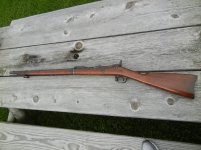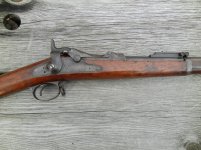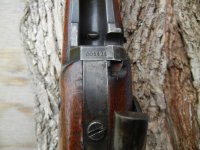Iggy,
Thanks for the link to the trapdoor dates and info.
FWIW, here's my experience with a trapdoor carbine that I bought from and older gentleman back in the early '90's while still living in NJ.
It was in poor condition and not all there. It was propped up in the corner of his basement!

It had areas of white paint on it that took a lot of time/work to remove.
The trigger was broken, it had no rear sight and the hammer spring was also broken. The saddle ring was missing but the original bar was in place.
I bought a rear sight at a gun show in PA back then which was suppose to be original for a carbine but over the rears I had my doubts. It still on the gun.
The bore is somewhat pitted but not too bad.
The breech block is marked US over Model with 18?? under that. I can't make out the rest of the date.
It shots pretty good with BP loads using a 405 gr. GC lead bullet over 55 gr. of FFg.

It was the only bullet I had at the time.
According to the chart and its serial #, 144XXX, it is one of 501 carbines made in 1881.
I replaced the broken parts with reproductions.
I tried selling it a couple of times but due to the condition and the non-original replacement parts, I had no takers.







